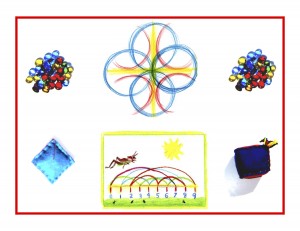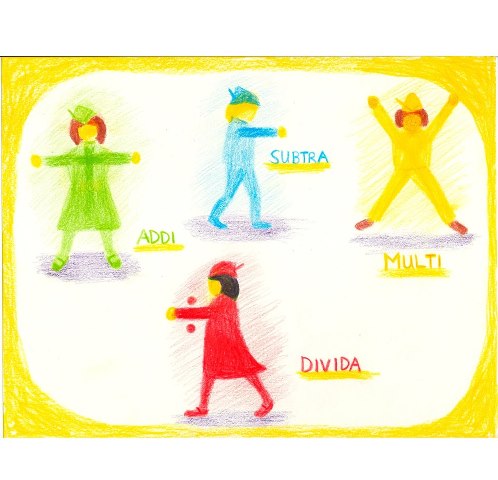Day 85
For one year, 365 days, this blog will address the Common Core Standards from the perspective of creating an alternate, ambient learning environment for math. Ambient is defined as “existing or present on all sides, an all-encompassing atmosphere.” And ambient music is defined as: “Quiet and relaxing with melodies that repeat many times.”
Why ambient? A math teaching style that’s whole and all encompassing, with themes that repeat many times through the years, is most likely to be effective and successful. Because the Common Core Grade 1 Math Standards address addition and subtraction exclusively, they will appear here later, in conjunction with the blocks that focus on the 4 processes. Earlier math blocks focus on meeting the numbers up close and personal through stories, movement, art, form drawing, and hands-on activities like making real numbers. The numbers should come together for calculation only after an in-depth introduction has established them as friendly and personable, so essential for circumventing math fears and phobias!
Only after a solid foundation has been built, with a thorough introduction and familiarity with the numbers themselves, where they came from, how they came to be, and how they relate to pictures and stories, should the numbers come together in calculation. There is no reason why all 4 processes should not be introduced together. If the calculations are kept simple (single digit and under 20) it’s immeasurably better to keep them together from the beginning. The following is an excerpt from the Math By Hand Grade 1 Binder.
The next step then is to bring the numbers together, to form relationships and characterize their interactions. It’s most effective to introduce all 4 processes at the same time, while illustrating their qualities, differences, and similarities. They can then be featured in the context of stories, costumes, and plays. In this way, their respective traits are brought to life, as they are each and all personified in various lively interactions. Here are suggestions for personalities and characterizations:
ADDITION/PLUS could be acquisitive, plump, GREEN and growing.
SUBTRACTION/MINUS is sad, BLUE and always losing things.
MULTIPLICATION/TIMES is complex and busy, YELLOW and very happy to be so.
DIVISION/DIVIDE is decisive, RED and definite.
A little costuming and story creation is all that’s needed to convey the “mood” of each of the processes. This concept goes a bit beyond math, since it can also be seen as a window into aspects of personality and character.
This is a formative time for the child. When the Grade 1 academic material is brought as an integral part of life, it can carry more than the merely abstract concepts. If presented in the right way, all the lessons will point beyond their immediate purpose. In that light, the traits of the 4 processes can be a mirror, reflecting qualities that resonate on deeper levels.
Along with the qualities mentioned above, others can be added in a complementary way. For instance, PLUSmight be seen as industrious and persevering, as well as greedy and acquisitive, as she stays with the job to the very end, until it’s finished. One view of MINUS might be that he is sad and always losing things. But another aspect could be that he is generous and always giving things away. Likewise TIMES, besides being complex and busy, could also be said to be helpful, willing to take on more than his share. And DIVIDE, as decisive and definite as she is, may also be called upon to be an impartial judge, because of her fairness and accuracy.
Awareness of the child(ren)’s temperaments can be helpful. There are 4 temperaments in all, and we all have a bit of each one, with one or two that predominate. These are universal qualities or personality traits that tend to be more singularly individual at first. As the child matures, the dominant trait is often modified or balanced, blending with the others. When these qualities are mirrored back, as they can be with the 4 processes characterizations, it is helpful for the child, as it promotes an understanding tolerance of self and others.
Create plays and stories around the four personalities, enabling them to become knowably approachable. Give them names like the more formal ones listed below or choose familiar nicknames like those in the drawing at the bottom of this post. The characters and their respective colors should be a persistent theme. For example, have Addy or Plus appear with all addition problems. Same for Subtra/Minus, Multi/Times, and Divida/Divide.
Knowledge ensues in an environment dedicated to imaginative, creative knowing, where student and teacher alike surrender to the ensuing of that knowledge as a worthy goal. Tune in tomorrow for examples of plays and stories used to introduce the 4 processes.
CHOLERIC . . . DIVISION . . . “DIVIDE” . . . RED
PHLEGMATIC . . . ADDITION . . . “PLUS” . . . GREEN
MELANCHOLIC . . . SUBTRACTION . . . “MINUS” . . . BLUE
SANGUINE . . . MULTIPLICATION . . . “TIMES” . . . YELLOW













